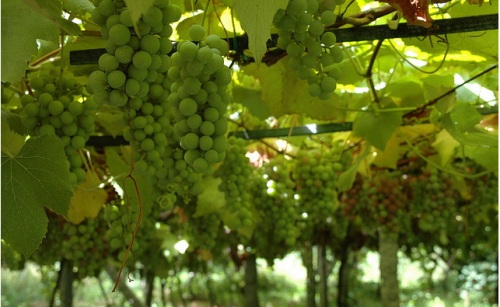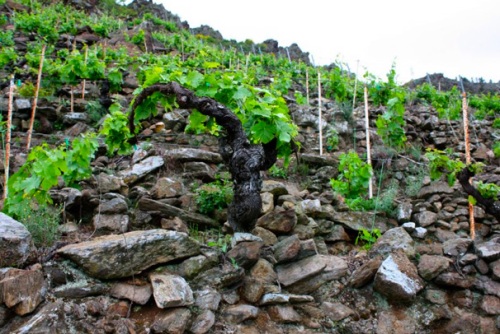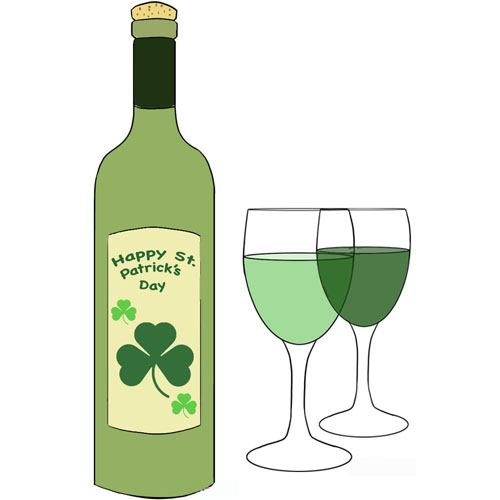I know what you’re thinking. You’re like, “Jeez, Caroline, can’t you use the one most obvious holiday as an excuse to talk about something other than wine?” And I hear ya, I do. I could totally use St. Patrick’s Day as an excuse to talk about craft beers or local whiskeys made from micro-distilleries just a subway ride away. But then I’d be just like everyone else, wouldn’t I?
So instead, I’m going to use the holiday as a good reason to talk about the wines of “Green Spain.” “Uugghh. Spain? On St. Patrick’s Day. Really???” Yep. Really. For a couple reasons.

A beauty shot of - nope! Not Ireland! Green Spain! Image used under Creative Commons via talliskeeton (Flickr)
The first is that this region of northern Spain is referred to as Green Spain because the area’s combination of ocean influences and rain contribute to lush growth that is reminiscent of Great Britain, Normandy, and – you guessed it – Ireland! Also, a nifty little fact about the area is that it was settled by the Celts nearly 3,000 years ago – the same band of merry marauders who would settle Great Britain and – wait for it – Ireland! One of the Celt’s most enduring legacies in the area is the survival of the Galician language – often spoken and taught in schools of the region right along side Spanish. So in a way, the wines of Green Spain are the closest the Irish have come to producing world-class wine – a fact that makes it the perfect subject for a St. Patrick’s Day post (curious to see what I wrote about last year? Click away).
In particular, I want to focus on the regions of Rías Baixas (pronounced ree-ass bye-shass), known for its white wines made from the grape Albariño; Valdeorras, an interesting up-and-coming region producing wine from an indigenous grape called Godello; and Bierzo, a region where one of my favorite wines, Mencía, is made.
Rías Baixas, as a wine region, really didn’t come of age until the late 1980’s and early 1990’s, when winemakers of the region were introduced to modern technologies such as stainless steel tanks. From there, the quality of the region’s white wines absolutely took off and were soon recognized as among the best white wines in Spain. Albariño is a grape that makes a wine with a soft and sometimes creamy texture yet high acidity (making it an ideal companion for sea food) and flavors that can range from zippy citrus, peach and apricot to floral and sweet almond. Some of the best Albariño is also quite affordable – ranging in price from $10-15 a bottle.
Valdeorras is further inland than Rías Baixas and Godello is planted in vineyards on the banks of the river Sil. Godello is an ancient grape with a long storied past in the region, but was only revived and revisited by winemakers in the 1970’s. Godello can be made in two distinct styles; young and barrel-aged. Young Godellos (Joven) are fermented in stainless steel and taste pure and minerally with lemony acidity and notes of wildflowers. Many winemakers are also experimenting with oak and making Godellos aged in barrels; these wines are more honeyed, with notes of vanilla and the stony quality of the grape coming through on the finish.

Godello grapes just hangin' out, gettin' ripe. Image used under Creative Commons via Asier Sarasua (Flickr)
Bierzo, outfitted with a perfect microclimate for viniculture, is home to the lovely Mencía. Mencía makes a wine that is traditionally lighter in body with a distinctly floral nose, flavors of bright ripe cherries and cranberries, and often a streak of herbs or anise. Just like with Godello, winemakers in the region have become bolder with their use of oak barrels for aging the wine, and its not hard to find a bottle imbued with toasty oak and spice, bigger in body than your average Mencía, but that still captures the grape’s exotic floral notes and lively fruit.

Old gnarly Mencia vines planted on slopes in the Ribeira Sacra, a region, along with Bierzo, that makes some of the best Mencia. Image via Jose Pastor Selections.
So, have I convinced you that the wines of Green Spain are worthy of your attention this St. Patrick’s day? I’ve listed some bottles below that fall below the $25 price point (except for one Mencía) for your perusing pleasure. Cheers!
Albariño:
Martin Codax ($10-15): A great introduction to Albariño, Martin Codax’s examples have gorgeous aromatics, full body, crisp acidity, and notes of pear, passion fruit, and apple on the palate. Clean, bright, and straightforward, you can’t go wrong.
Rosalia de Castro ($11): The Paco & Lola Albariño from this producer offers quite a different take on the grape, but one that is no less delightful. Herbacious and floral rather than fruit-driven, this is a super fresh wine. Full, crisp, and with a persistent finish, this wine would be great with sushi.
Adega Eidos ($22): This producer makes Albariño that is very terroir-driven, usually showing intense minerality that can range from stony to briny. Balanced by bright notes of lemon and flowers, these Albariños are complex and lengthy – great wines to pair with seafood.
Godello:
Bodega Del Abad ($10-16): This is a Godello from Bierzo, rather than Valdeorro (which are, unfortunately, pretty hard to come by stateside). Made in the young style and fermented in stainless steel, this Godello is minerally and spicy with bright notes of grapefruit and green apple. Super fresh but still fairly full-bodied and lengthy, it is a great example of Godello Joven.
A Tapada ($20-$24) From Valdeorro, this Godello is made much more in the new barrique style. Waxy, firm, and full in body, with notes of citrus and flowers, this creamy Godello has a slightly nutty character, too.
Mencía:
Benaza Mencía ($10-15): I’ve written about this super wallet-friendly Mencía before, so its no secret that its one of my faves. Light, earthy, and with a tartness that brings to mind cranberries, it also has wonderful balance and a dry finish that makes it go well with food.
Luna Beberide ($12.99): A more medium-bodied Mencía that spends some time in oak -giving it soft tannins and a touch of smoke and vanilla. This producer’s Mencías have consistently made numerous “bang for your buck” lists, and with good reason. It’s a thinker’s wine that evolves in the glass.
Guimaro ($15): If you love Cru Beaujolais as much as I do (and that ain’t no secret), then this is a great Mencía for your introduction to the grape. Violets, cherries, and some slightly smoky, earthy qualities all make this light-to-medium bodied wine delightful.
Gancedo ($19-25): A thoroughly modern Mencía, made with plenty of exposure to oak, this is a full-force wine. On the nose, notes of blackberry, liquorice, and stones lead into a wine that tastes of dark fruit and chocolate.
Descendientes de J. Palacios Petalos ($23): This is one of the most widely available bottles of Mencía in NYC. I see it all the time, so I know it’s fairly accessible. A floral nose of roses with some pink peppercorns, bright and earthy, plush and silky, this is a pretty decent price, too, for such an elegant expression of the grape.
Raul Perez Ultreia San Sacques ($30): Raul Perez is a groundbreaking winemaker in the region. Not only does he produce complex, intense wines that redefine everything you thought you knew about Mencía, but he also works with a number of other winemakers in the region as a consultant. This bottle is his most accessibly priced and a wonderful introduction to Perez – his wines can cost upwards of $90.









